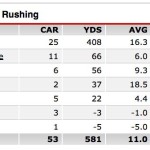College Football Handicapping – Point of Attack Play
College Football Handicapping – Who will run the football effectively and have better point of attack play?
Many of you that have followed me for years and read my NFL and college football handicapping articles on rushing guidelines know I incorporate point of attack play into my fundamental handicapping approach. The ability to run the football and stop the run sets up so many other opportunities in the passing game and down and distance opportunities for the offense and defense.

Wisconsin RB Melvin Gordon rushed for 408 yards vs Nebraska last yr – in 3 Qtrs
For many seasons I have written a weekly NFL article outlining rushing guidelines and how to use them and handicap future games using this fundamental approach. But in college football there is greater variance and differences in the rushing attacks as teams can have a much bigger advantage physically and in styles of play in the college game. So while we use different guidelines and numbers in college due to the bigger rushing numbers and mismatches that can unfold, the premise remains similar. We look to identify which teams can control the line of scrimmage and establish an effective and efficient running game, and also determine which team can slow or stop the run. Yards per rush for and against is one statistical measure to use, and in college you must understand that quarterback sacks are counted as rushing plays, so sack yardage lost can swing the yards per rush stats significantly. Whether you use the NCAA rushing stats or adjust your numbers for true rushing yards and remove sack yardage, the process remains the same.
While scoring is up to an average of 56 points per game in college football and the media and many college football analysts and writers tell you that the passing game has taken over the game, know that the fundamentals of football remain the same. Blocking, tackling, running, catching. Yes passing may be more paramount to scoring success in today’s game, but I assure you that if you identify the teams that will have more success running the football and/or stopping the run, you’ll not only select more straight up winners, but more importantly point spread winners.
The ability of a team to balance the offense will prove of great importance as the season wears on, and I’ll have articles about that during the season as we accumulate more year-to-date data. By midseason last year, there were 15 teams that both rushed and passed for at least 200 yards per game against FBS opponents, and I provided that list and those teams value in an article outlining powerful, balanced offenses.
However, as you analyze stats and match-ups each week, see if you can project certain yardage for each team. If you’re able to identify which team will hold a significant advantage in running the football and stopping the run, you’ve put yourself in a very strong position to cash a winning ticket.
Why? Because over the last four years, there has been nearly 1,000 college football games in which one team has out-rushed the opponent by at least a 2-1 margin. And those teams have covered the point spread 75% of the time. If you track the stats and box scores each week, you’ll see what I’m talking about. So if a team rushes for 220 yards and the opponent rushes for 110 or less, you have a 75% chance to cover the spread. Only 110 yards rushing? If the opponent rushed for just 50 yards, you have a great shot to cash.
Now, it’s not easy to project these ‘double-rushers’ each week. Teams like Air Force or Army who almost exclusively run the ball are easier to project. Pass-heavy teams like Washington State rarely fit our criteria, so you handicap the game differently accounting for the passing game, pace and number of plays, and opponents style of play and ability to defend the pass.
Can you project when a team like Texas is going to run the ball 18 times for just 2 yards like they did in their bowl game loss to Arkansas last season? Probably not, but you sure knew that the Razorbacks were going to run often as one of the top rushing attempts teams in the country, and even above their season average with 50 attempts for 191 yards in a dominating 31-7 win. And you should have identified how dominating the ‘Hogs defense was down the stretch.
So analyze point of attack play and try to project running game success and which teams will also slow the opponents running attack. Use rushing attempts as a guideline. Impact injuries along the offensive or defensive line. Coaches and game plans to control the clock and if they are physically able to do so against an opponent or hold up in the trenches to stop an opponent. Weather, wear and tear, motivation and momentum or letdown situations are additional factors that go into the evaluation.
But start with the stats looking at yards per rush for and against, yards per rush and rushing attempts, and then factor in strength of schedule and opponents. Review the other factors discussed. As you build a foundation and handicap some of these rushing parameters and point of attack play, you’ll build a more predictable and precise evaluation to help you in your pursuit of profit and more reliable forecasting.


 Twitter
Twitter Facebook
Facebook